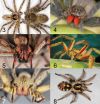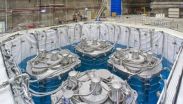(Press-News.org) CINCINNATI – Researchers developed a new type of cell transplantation to treat mice mimicking a rare lung disease that one day could be used to treat this and other human lung diseases caused by dysfunctional immune cells.
Scientists at Cincinnati Children's Hospital Medical Center report their findings in a study posted online Oct. 1 by Nature. In the study, the authors used macrophages, a type of immune cell that helps collect and remove used molecules and cell debris from the body.
They transplanted either normal or gene-corrected macrophages into the respiratory tracts of mice, which were bred to mimic the hereditary form of a human disease called hereditary pulmonary alveolar proteinosis (hPAP). Treatment with both normal and gene-corrected macrophages corrected the disease in the mice.
"These are significant findings with potential implications beyond the treatment of a rare lung disease," said Bruce Trapnell, MD, senior author and a physician in the Division of Neonatology and Pulmonary Biology at Cincinnati Children's. "Our findings support the concept of pulmonary macrophage transplantation (PMT) as the first specific therapy for children with hPAP"
"Results also identified mechanisms regulating the numbers and phenotype of macrophages in the tiny air sacs of the lungs (called alveoli) in health and disease," said Takuji Suzuki, MD, PhD, the study's first author and a scientist in the Division of Neonatology and Pulmonary Biology at Cincinnati Children's.
Suzuki and Trapnell discovered hPAP at Cincinnati Children's and first reported it in 2008. In hPAP, the air sacs become filled with surfactant, a substance the lungs produce to reduce surface tension and keep the air sacs open. Children with hPAP have mutations in the genes of GM-CSF receptor alpha or beta (CSFR2RA or CSFR2RB). These mutations reduce the ability of alveolar macrophages to remove used surfactant from the lungs of these children.
The used surfactant builds up in the lungs, filling the alveoli and causing difficult breathing or respiratory failure. The only current treatment for these children is whole-lung lavage, an invasive lung-washing procedure performed under general anesthesia. Although the procedure works, it is temporary, must be repeated frequently, and creates quality of life issues for affected children.
Previous studies have tested bone marrow transplant (BMT) to treat mouse models of hPAP – which involves myeloablation, or using radiation and/or chemotherapy to destroy existing bone marrow. BMT was effective in mice, but in humans resulted in death before the new bone marrow grew and expanded (called engraftment) in treated patients.
Trapnell and Suzuki were prompted to test the novel macrophage transplantation therapy by studies showing that resident macrophage populations (such as those residing in the lung) can self-maintain without the cells having to regenerate directly from the bone marrow. Results showed that naturally healthy macrophages and gene-corrected macrophages worked equally well in correcting the disease in the mice.
In mice mimicking hPAP that lacked expression of the mouse gene - Csf2rb, the researchers used a viral vector to deliver a correct version of Csf2rb to abnormal alveolar macrophages taken from the animals. The gene-corrected cells were then administered back to the mice by direct instillation into the lungs.
The researchers report that treatment was safe, well tolerated by the animals, and that one administration corrected the lung disease, normalized disease-related biomarkers and prevented disease-specific mortality for at least one year.
Although the gene/cell therapy strategy was highly successful in laboratory mice, the authors stressed that additional research and testing are needed before the therapy could be tested in humans. They must still confirm the precise pharmacokinetics, or how the body processes the therapy after it is administered. Also needed is data to help determine appropriate dosage levels and therapeutic duration following treatment. The pre-clinical studies needed are now in progress and planning for the human studies is underway.
INFORMATION:
Funding for the study came in part from the National Institutes of Health (R01 HL085453, R21 HL106134, R01HL118342, 8UL1TR000077-05, AR-47363, DK78392, DK90971), the American Thoracic Society Foundation, a Cincinnati Children's Foundation Trustee Grant, Deutsche
Forschungsgemeinschaft, the Else Kroner-Fresenius Stiflung, Eva-Luise Koehler Research for Rare Diseases 2013, and the Division of Neonatology and Pulmonary Biology at Cincinnati Children's.
Suzuki and Trapnell also have faculty appointments in the University of Cincinnati College of Medicine.
About Cincinnati Children's:
Cincinnati Children's Hospital Medical Center ranks third in the nation among all Honor Roll hospitals in U.S. News & World Report's 2014 Best Children's Hospitals. It is also ranked in the top 10 for all 10 pediatric specialties. Cincinnati Children's, a non-profit organization, is one of the top three recipients of pediatric research grants from the National Institutes of Health, and a research and teaching affiliate of the University of Cincinnati College of Medicine. The medical center is internationally recognized for improving child health and transforming delivery of care through fully integrated, globally recognized research, education and innovation. Additional information can be found at http://www.cincinnatichildrens.org. Connect on the Cincinnati Children's blog, via Facebook and on Twitter.
Researchers develop novel gene/cell therapy approach for lung disease
2014-10-01
ELSE PRESS RELEASES FROM THIS DATE:
New frontier in error-correcting codes
2014-10-01
CAMBRIDGE, Mass--Error-correcting codes are one of the glories of the information age: They're what guarantee the flawless transmission of digital information over the airwaves or through copper wire, even in the presence of the corrupting influences that engineers call "noise."
But classical error-correcting codes work best with large chunks of data: The bigger the chunk, the higher the rate at which it can be transmitted error-free. In the Internet age, however, distributed computing is becoming more and more common, with devices repeatedly exchanging small chunks of ...
Coral reef winners and losers
2014-10-01
Contrary to the popular research-based assumption that the world's coral reefs are doomed, a new longitudinal study from UC Santa Barbara's National Center for Ecological Analysis and Synthesis (NCEAS) paints a brighter picture of how corals may fare in the future.
An NCEAS working group reports that there will be winners and losers among coral species facing increasing natural and human-caused stressors. However, its experts demonstrate that a subset of the present coral fauna will likely populate the world's oceans as water temperatures continue to rise. The findings ...
Proving 'group selection'
2014-10-01
PITTSBURGH—The notion of "group selection"—that members of social species exhibit individual behavioral traits that render a population more or less fit for survival—has been bandied about in evolutionary biology since Darwin. The essence of the argument against the theory is that it's a "fuzzy" concept without the precision of gene-based selection.
Jonathan Pruitt, assistant professor of behavioral ecology in the University of Pittsburgh's Department of Biological Sciences within the Kenneth P. Dietrich School of Arts and Sciences, has published a paper today in the ...
New study provides key to identifying spiders in international cargo
2014-10-01
Spiders found in international cargo brought into North America are sometimes submitted to arachnologists for identification. Often, these spiders are presumed to be of medical importance because of their size or similarity to spiders that are known to be venomous.
In 2006, after witnessing multiple episodes where harmless spiders were mistaken for toxic ones, Dr. Richard Vetter, an arachnologist at the University of California, asked other arachnologists to provide data on specimens they found in international cargo that had been submitted to them for identification. ...
Scientists aim to give botox a safer facelift
2014-10-01
New insights into botulinum neurotoxins and their interactions with cells are moving scientists ever closer to safer forms of Botox and a better understanding of the dangerous disease known as botulism. By comparing all known structures of botulinum neurotoxins, researchers writing in the Cell Press journal Trends in Biochemical Sciences on October 1st suggest new ways to improve the safety and efficacy of Botox injections.
"If we know from high-resolution structures how botulinum neurotoxins interact with their receptors, we can design inhibitors or specific antibodies ...
Journal supplement examines innovative strategies for healthy aging
2014-10-01
WASHINGTON— The Society for Public Health Education (SOPHE) proudly announces the publication of a Health Education & Behavior (HE&B) supplement devoted to the latest research and practice to promote healthy aging. The October 2014 supplement, "Fostering Engagement and Independence: Opportunities and Challenges for an Aging Society," contains a dozen peer-reviewed articles on innovative behavioral and psycho-social approaches to improve the health of the nation's fastest growing cohort - older adults.
Together the articles describe promising advances in research directed ...
Hide and seek: Sterile neutrinos remain elusive
2014-10-01
BEIJING; BERKELEY, CA; and UPTON, NY - The Daya Bay Collaboration, an international group of scientists studying the subtle transformations of subatomic particles called neutrinos, is publishing its first results on the search for a so-called sterile neutrino, a possible new type of neutrino beyond the three known neutrino "flavors," or types. The existence of this elusive particle, if proven, would have a profound impact on our understanding of the universe, and could impact the design of future neutrino experiments. The new results, appearing in the journal Physical Review ...
New approach can predict impact of climate change on species that can't get out of the way
2014-10-01
CUMBERLAND, MD (October 1, 2014)--When scientists talk about the consequences of climate change, it can mean more than how we human beings will be impacted by higher temperatures, rising seas and serious storms. Plants and trees are also feeling the change, but they can't move out of the way. Researchers at the University of Maryland Center for Environmental Science and University of Vermont have developed a new tool to overcome a major challenge of predicting how organisms may respond to climate change.
"When climate changes, organisms have three choices: migrate, adapt, ...
Treatment of substance abuse can lessen risk of future violence in mentally ill
2014-10-01
BUFFALO, N.Y. — If a person is dually diagnosed with a severe mental illness and a substance abuse problem, are improvements in their mental health or in their substance abuse most likely to reduce the risk of future violence?
Although some may believe that improving symptoms of mental illness is more likely to lessen the risk for future episodes of violence, a new study from the University at Buffalo Research Institute on Addictions (RIA) suggests that reducing substance abuse has a greater influence in reducing violent acts by patients with severe mental illness. ...
A new target for controlling inflammation? Long non-coding RNAs fine-tune the immune system
2014-10-01
New Rochelle, NY, October 1, 2014—Regulation of the human immune system's response to infection involves an elaborate network of complex signaling pathways that turn on and off multiple genes. The emerging importance of long noncoding RNAs and their ability to promote, fine-tune, and restrain the body's inflammatory response by regulating gene expression is described in a Review article in Journal of Interferon & Cytokine Research (JICR), a peer-reviewed publication from Mary Ann Liebert, Inc., publishers. The article is available free on the JICR website.
In the Review ...




